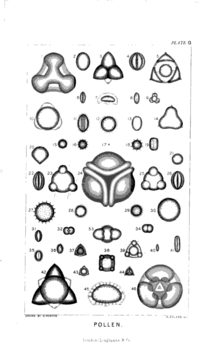- Mungo Ponton
-
Mungo Ponton FRS (20 November 1801 – 3 August 1880) was a Scottish inventor who in 1839 created a method of permanent photography based on sodium dichromate.
Mungo was a farmer's son, born and raised in Edinburgh. He became a legal apprentice and was admitted to the Society of Writers to the Signet, a legal fraternity, on 8 December 1825. He married Helen Scott Campbell on 24 June 1830 and the couple had seven children. His first wife died on 7 August 1842 and he married his second wife, Margaret Ponton (possibly related), on 7 November 1843 with whom he had a son. Mungo suffered a breakdown around 1845 and moved to Bristol, England for its milder climate. He married his third wife, Jean McLean, on 1 August 1871. Ponton died at his home in Clifton, Bristol on 3 August 1880.[1]
Inventor
 Photographs of Pollen[2]
Photographs of Pollen[2]
On 20 June 1834, Mungo became a Fellow of the Royal Society of Edinburgh. In 1838, the Society of Arts for Scotland awarded Mungo the silver medal for his contributions to the development of the electrical telegraph.
In 1839, while experimenting with early photographic processes developed that year by William Henry Fox Talbot, Mungo discovered the light-sensitive quality of sodium dichromate. He presented his findings to the Society of Arts for Scotland on 29 May. Mungo did not attempt to patent the photographic process and published his findings in the Edinburgh New Philosophical Journal. Others experimented with his discovery including Talbot, Edmund Becquerel, Alphonse Poitevin, and John Pouncey, all of whom patented their photographic techniques.[1]
Mungo continued to work on photography and in 1845 the Society again awarded him a silver medal for his process for measuring the hourly variation in temperature of photographic paper. That year he also developed a variation on the calotype process to allow for shorter exposure times.[1]
Bibliography
- The Great Architect; as Manifested in the Material Universe (1866)
- Earthquakes and Volcanoes: Their History, Phenomena, and Probable Causes (1868)
- The Beginning: Its When and Its How (1871)
- Glimpses of the Future Life (1873)
- Songs of the Soul: Philosophical Moral and Devotional (1877)
References
- ^ a b c Simpson, Roddy (2008). "Ponton, Mungo (1801–1880)". In John Hannavy. Encyclopedia of Nineteenth-century Photography. vol. 1. CRC Press. pp. pp. 1146–7. ISBN 9780415972352. http://books.google.com/books?id=PJ8DHBay4_EC.
- ^ Ponton. F.R.S.E., Mungo (1871). "Plate O". The Beginning: Its When and Its How. London: Longmans, Green, and Co.. http://books.google.com/books?id=-SIaAAAAYAAJ&pg=RA1-PA567. Retrieved 2009-04-05.
Categories:- 1801 births
- 1880 deaths
- Scottish inventors
- Pioneers of photography
- Fellows of the Royal Society of Edinburgh
Wikimedia Foundation. 2010.

